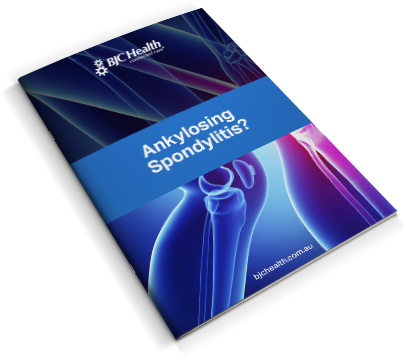How is Ankylosing Spondylitis Diagnosed?
There is no one single test that is able to diagnose AS. Instead the diagnosis is derived from a combination of clinical and radiological features. This has led to a number of criteria that have aimed to be most specific in identifying those affected with the disease. The most commonly used criteria were created in New York, which were modified in 1984. The criteria includes:
1. Clinical criteria
- Low back pain and stiffness for more than 3 months which improves with exercise, but is not relieved by rest
- Limitation of motion of the lumbar spine in both the sagittal (front-back) and frontal planes (side-side) – which refers to the direction of movement
- Limitation of chest expansion relative to normal values corrected for age and sex – which reflects the degree of movement in the midback where it joins onto the rib cage.
2. Radiologic criteria
- Sacroiliitis on radiographs
Definite AS is diagnosed if the radiologic criteria is satisfied with the presence of at least 1 clinical criterion
Probable AS is diagnosed if
- Three clinical criteria are present
- Radiologic criterion present without any signs or symptoms satisfying the clinical criteria
The main aim of these diagnostic criteria, such as the modified New York criteria, is to ensure a uniform population of patients with AS for the purpose of research. Consequently, such an approach to diagnosis is unlikely to identify patients with early disease because of the need to have limitation of motion and the presence of radiological change, both of which often requires a significant amount of time to develop. Therefore, recent interest has focused on how to identify patients in the early phase of their illness.
In this regard the Assessment of SpondyloArthritis international Society (ASAS) developed criteria for the diagnosis of Axial Spondyloarthritis, which defines the scenario when an inflammatory spinal disease is present that does not fulfill the criteria for a specific subtype. The criteria is presented below;

Criteria for the diagnosis of Axial Spondyloarthritis (Published by Rudweleit et al 2009 Annals of Rheumatic disease 68: 777-783)
In this criterion, imaging includes the use of MRI scanning, which is able to demonstrate inflammation at the affected joints. The advantage of this approach is that patients can be identified early, prior to the onset of any structural damage, such that treatment can be commenced with the aim of retarding or ideally preventing the long-term sequelae of the disorder. This is further emphasized by the fact that a large proportion of disease progression and functional loss occurs in the first ten years of the disease.
There are a number of other investigations that are useful for the Rheumatologist in the assessment of Ankylosing Spondylitis and the related disorders, even though these may not be necessary or useful in the diagnosis. Of these, the inflammatory markers are worthy of mention. The markers of inflammation that are most commonly measured are the C-Reactive Protein (CRP) and the Erythrocyte Sedimentation Rate (ESR). These measures are elevated at some time in the course of the disease in 50-70% of patients, which may but not always correlate with disease activity. As such, these tests, may have a limited role in the diagnosis and monitoring of the disease. It seems that these tests are most useful in those patients who have an arthritis affecting joints other than the spine. In addition, ultrasound evaluation, especially with Power Doppler, has proven useful when assessing for inflammation at the sites where tendons join onto bone, called entheses, especially when that inflammation is not clinically apparent. However, ultrasound has not been of much use in the evaluation of spinal symptoms.
What is Ankylosing Spondylitis?
Download this eBook on this inflammatory rheumatic condition
Understand the causes, the signs and symptoms, how it's diagnosed and most importantly how it's treated.
Download
Get the help you deserve - talk to our friendly team today! 1300 252 698
Our Latest Articles
Like most rheumatologists, the doctors at BJC ....
Ketosis, bulletproof coffees, keto flu, fat ....
Now one thing I have found as an Exercise ....
-
What is chair yoga and is it for me?
By
Rhianne Kerr on June 8, 2020
Now one thing I have found as an Exercise Physiologist and Yoga Teacher, is that a traditional yoga practice is not necessarily for everyone. It can ...
BJC Health and Fitness -
Restricting medical care to traditional in-clinic consultation is so 20th century!
By
 Dr Irwin Lim
on May 17, 2020
Dr Irwin Lim
on May 17, 2020
Like most rheumatologists, the doctors at BJC Health have fixed session times at various clinics where we consult. We typically start at 0800 and end ...
BJC Connected Care -
Feeling more aches and pains?
By
 Sarah Comensoli
on May 10, 2020
Sarah Comensoli
on May 10, 2020
We totally appreciate at the moment that some of our clients are experiencing more aches and pains than they’re usually accustomed to, and we get it. ...
BJC Health and Fitness -
How our Rheumatology service might look after 6 months of the Covid-19 pandemic
By
 Dr Irwin Lim
on April 20, 2020
Dr Irwin Lim
on April 20, 2020
On the 5th March, our team of BJC Health leaders met in my living room to discuss our plans for the next 10 years. The planning phase had commenced 4 ...
BJC Connected Care -
Emergency Rheumatology Service for those who can't attend hospital clinics during COVID-19 pandemic
By
 Dr Irwin Lim
on April 14, 2020
Dr Irwin Lim
on April 14, 2020
Thank you for the kind words and support you’ve provided BJC Health on social media. Our multidisciplinary team is working hard to engage and develop ...
BJC Connected Care -
How Covid-19 sped up Rheumatology Telehealth delivery
By
 Dr Irwin Lim
on April 7, 2020
Dr Irwin Lim
on April 7, 2020
It’s been a really challenging time for us at BJC Health as I am sure it has been for all of you. If one good thing has come out of the COVID-19 ...
BJC Connected Care -
Asked to see a Physio for a Metrology Assessment? Here's what to expect.
By
Dominic Fitzgerald on March 11, 2020
If you have recently been diagnosed with Ankylosing Spondylitis (AS) or a Spondyloarthropathy (SpA), some Rheumatologists might look to refer you to ...
BJC Health and Fitness -
Struggle with climbing stairs? Here are some tips to make it easier
By
Paul Scalise on February 23, 2020
Picture this: You’re up and walking about, doing some shopping – you’re got some large bags, heavy with food for the week. You are done for the day, ...
BJC Health and Fitness -
3 breathing exercises to help you relax
By
Rhianne Kerr on February 16, 2020
Life can absolutely get stressful and overwhelming at times…Often in those moments of stress, you may notice that your breathing becomes shallow, and ...
BJC Health and Fitness -
Chewing the fat. Is the keto diet the way to go?
By
Stephanie Hage on January 27, 2020
Ketosis, bulletproof coffees, keto flu, fat bombs… all buzzwords that you might hear related to the ketogenic (keto) diet. But what exactly is the ...
BJC Diet and Nutrition -
Game changers: is a plant-based diet the key to good health?
By
Stephanie Hage on December 19, 2019
Game Changers - it’s the documentary that everyone is talking about. It seems as though one day I woke up, opened my Instagram account and found ...
BJC Diet and Nutrition -
The Portfolio Diet...Does it help with inflammation?
By
Stephanie Hage on October 23, 2019
As a dietitian, the word “diet” is probably my least favourite word. I appreciate that for many, this single word can bring up past memories of ...
BJC Diet and Nutrition -
Diet Mythbusters!
By
Stephanie Hage on September 19, 2019
The internet can be both your best friend and worst enemy when it comes to finding information about food. If you have a rheumatic disease such as ...
BJC Diet and Nutrition -
Are you realllyy eating well?
By
Stephanie Hage on August 23, 2019
What does eating well mean to you? It could be: Keeping your blood test results in check Eating adequate serves of food from each of the food groups ...
BJC Diet and Nutrition -
Introducing Rheumatology Republic - Join our community!
By
 Dr Irwin Lim
on March 5, 2019
Dr Irwin Lim
on March 5, 2019
I’m sorry that I’ve been missing from this blog. I was galvanized to start blogging in late 2010 to try and rectify community attitudes to ...
BJC Connected Care
BJC Parramatta
Level 1, 17-21 Hunter Street,
Parramatta NSW 2150
Tel: +61 2 9890 7633
Fax: 02 98907655
BJC Chatswood
Ground floor, 7 Help Street,
Chatswood NSW 2067
Tel: +61 2 9413 2979
Fax: 02 9413 3316
BJC Bondi Junction
Suite 105, Level 1, 332-342 Oxford Street,
Bondi Junction NSW 2022
Tel: +61 2 9055 1790
Fax: 02 9169 3497

